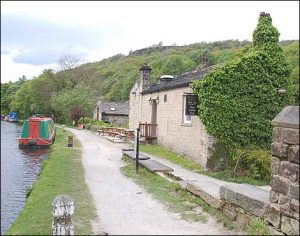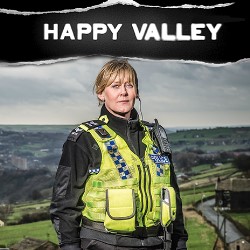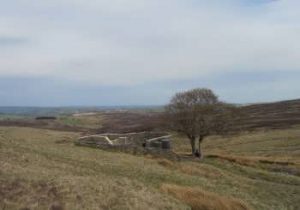 I’ve just returned from my second Arvon course under the Arts Council grant, this time at Lumb Bank, an imposing eighteenth century mill owner’s manse glowering down a steeply wooded hillside to where the ruined mill chimneys can still be seen. The concept of Arvon, the grandaddy of UK creative writing courses, was founded in Devon by poets John Moat and John Fairfax in l968 as a reaction against what they saw as a staid, dogmatic approach to teaching poetry. Lumb Bank was Ted and Carol Hughes’ home for a short while and was leased to Arvon when Hughes suggested it was time to open a Northern centre. The Arvon formula is the same in all three centres: two tutors, a guest reader mid-week and up to 16 anxious but starry-eyed participants. Fantastic poets and tutors Jean Sprackland and Jacob Polley had fun with an ever-changing good cop/bad cop formula and knocked us all into better shape with grace, sensitivity and humour, coaxing (or, perhaps, ripping!) seven very different poems out of me in just four days. Sean Borodale arrived on Wednesday night for his guest slot looking like a floppy-haired 21st century version of Keats to read his profound and erudite poems on subjects ranging from peeling and stewing apples to an extraordinary contemplation of a queen bee…
I’ve just returned from my second Arvon course under the Arts Council grant, this time at Lumb Bank, an imposing eighteenth century mill owner’s manse glowering down a steeply wooded hillside to where the ruined mill chimneys can still be seen. The concept of Arvon, the grandaddy of UK creative writing courses, was founded in Devon by poets John Moat and John Fairfax in l968 as a reaction against what they saw as a staid, dogmatic approach to teaching poetry. Lumb Bank was Ted and Carol Hughes’ home for a short while and was leased to Arvon when Hughes suggested it was time to open a Northern centre. The Arvon formula is the same in all three centres: two tutors, a guest reader mid-week and up to 16 anxious but starry-eyed participants. Fantastic poets and tutors Jean Sprackland and Jacob Polley had fun with an ever-changing good cop/bad cop formula and knocked us all into better shape with grace, sensitivity and humour, coaxing (or, perhaps, ripping!) seven very different poems out of me in just four days. Sean Borodale arrived on Wednesday night for his guest slot looking like a floppy-haired 21st century version of Keats to read his profound and erudite poems on subjects ranging from peeling and stewing apples to an extraordinary contemplation of a queen bee…
 The weather was glorious except for the day I had cooking and washing up duty (sometimes the best-laid plans actually work out!). I did a daily walk down to Hebden Bridge to sit by the canal with a beer at Stubbings Wharf or a coffee at The Den watching the sun on the painted barges and dodging the hissing geese before the steep walk back up via Heptonstall.
The weather was glorious except for the day I had cooking and washing up duty (sometimes the best-laid plans actually work out!). I did a daily walk down to Hebden Bridge to sit by the canal with a beer at Stubbings Wharf or a coffee at The Den watching the sun on the painted barges and dodging the hissing geese before the steep walk back up via Heptonstall.  Sylvia Plath is buried in the new graveyard in this village which is a fifteen-minute walk from Lumb Bank. I’ve been to this area quite a bit and was glad that I’d already “done” my Sylvia Plath poem some years back – it’s hard not to be influenced by these two extraordinary poets and hard not to let the beauty and harshness of nature overwhelm your poems. There was even a cat called Ted, although it was from the farm down the road and turned out to be a girl…
Sylvia Plath is buried in the new graveyard in this village which is a fifteen-minute walk from Lumb Bank. I’ve been to this area quite a bit and was glad that I’d already “done” my Sylvia Plath poem some years back – it’s hard not to be influenced by these two extraordinary poets and hard not to let the beauty and harshness of nature overwhelm your poems. There was even a cat called Ted, although it was from the farm down the road and turned out to be a girl…
The week was full of bizarre encounters and surreal coincidences. Taking a breather on the pair of benches on a grassed over burial mound which look across the valley at the top of the lane from Heptonstall to Lumb Bank I got chatting to a walker from Barnsley who had done a great number of Arvon courses and whose strongest memory was of a poem by Heidi Williamson who was a guest reader on a course he’d done at Totleigh Barton. When I said Heidi was a great friend of mine as well as my long-standing mentor he was, understandably, chuffed to bits and went off to tweet his news with a spring in his step!
 I discovered that one of the participants on the course had stayed in the same cottage in Mytholmroyd last April that Chris and I had rented in November during my birthday week. One of my presents was the first series of Happy Valley – it was a rainy week and we couldn’t stop watching it. Sally Wainwright’s flawless script, superb acting from a wonderful cast, particularly Sarah Lancashire and James Norton, and the fact that every night we walked along the dark canal back from Hebden Bridge to Mytholmroyd, passing the exact spot where the chillingly psychopathic Tommy Lee Royce had been hiding, all added to the dark and rather magnificent claustrophobia which permeates the Calder Valley on winter days. Sally Wainwright went to school in Sowerby Bridge and most of her scripts touch on this area (Sparkhouse, Scott and Bailey, Unforgiven etc) and, of course, Catherine Cawood, Sarah Lancashire’s character in Happy Valley, is often seen in Heptonstall at the graveside of her daughter Rebecca who is the invisible motivating factor behind the whole series. Calderdale has been used as a feature film location since Cecil Hepworth’s Helen of the Four Gates in 1920 and, with its sinister moor and heathlands, steep climbs, cobbled villages and solid stone buildings, it never fails to be a character in its own right.
I discovered that one of the participants on the course had stayed in the same cottage in Mytholmroyd last April that Chris and I had rented in November during my birthday week. One of my presents was the first series of Happy Valley – it was a rainy week and we couldn’t stop watching it. Sally Wainwright’s flawless script, superb acting from a wonderful cast, particularly Sarah Lancashire and James Norton, and the fact that every night we walked along the dark canal back from Hebden Bridge to Mytholmroyd, passing the exact spot where the chillingly psychopathic Tommy Lee Royce had been hiding, all added to the dark and rather magnificent claustrophobia which permeates the Calder Valley on winter days. Sally Wainwright went to school in Sowerby Bridge and most of her scripts touch on this area (Sparkhouse, Scott and Bailey, Unforgiven etc) and, of course, Catherine Cawood, Sarah Lancashire’s character in Happy Valley, is often seen in Heptonstall at the graveside of her daughter Rebecca who is the invisible motivating factor behind the whole series. Calderdale has been used as a feature film location since Cecil Hepworth’s Helen of the Four Gates in 1920 and, with its sinister moor and heathlands, steep climbs, cobbled villages and solid stone buildings, it never fails to be a character in its own right.
 On my birthday we walked from Haworth back to Hebden Bridge via Top Withens (Wuthering Heights to you and me!) on the kind of foggy day that just makes you want to write intensely passionate and romantic poetry (although I was slightly distracted by the fact that I’d turned my left eye into a giant purple puffball by picking a mushroom, trying to identify it and then rubbing my eye…)
On my birthday we walked from Haworth back to Hebden Bridge via Top Withens (Wuthering Heights to you and me!) on the kind of foggy day that just makes you want to write intensely passionate and romantic poetry (although I was slightly distracted by the fact that I’d turned my left eye into a giant purple puffball by picking a mushroom, trying to identify it and then rubbing my eye…)
 We also had a rather more up-to-date and positively post-apocalyptic experience that week when we went to the fantastic Trades Club on Hallowe’en to see a screening of Last Man on Earth, a schlocky B-movie made in Italy at the height of the horror era in 1968 (adapted from Richard Matheson’s novel I Am Legend and remade under this title in 2007 with Will Smith. There’s also a 1971 remake, The Omega Man, starring Charlton Heston). It stars Vincent Price as Dr Robert Morgan who wakes every morning in his garlic- festooned house to go vampire hunting (the film’s baddies are a confusing mix of zombie and vampire). The screening was accompanied with live music from Animat who used a mixture of their own brand of dubby downtempo music as well as an eclectic selection of tracks from their DJ archive including, inevitably, Thriller! Holme Street, where the Trades Club is situated, is a cul-de-sac T-junctioned by the Rochdale Canal and it tends to attract all sorts at night… We emerged into the darkness to be met by a ragged bunch of men staggering around in an inarticulate manner with an excitable black dog, echoing the repeated scenes in The Last Man on Earth where Vincent Price encounters angry zombies every morning when he opens his door and he even inadvertently adopts a zombie dog (black, of course!).
We also had a rather more up-to-date and positively post-apocalyptic experience that week when we went to the fantastic Trades Club on Hallowe’en to see a screening of Last Man on Earth, a schlocky B-movie made in Italy at the height of the horror era in 1968 (adapted from Richard Matheson’s novel I Am Legend and remade under this title in 2007 with Will Smith. There’s also a 1971 remake, The Omega Man, starring Charlton Heston). It stars Vincent Price as Dr Robert Morgan who wakes every morning in his garlic- festooned house to go vampire hunting (the film’s baddies are a confusing mix of zombie and vampire). The screening was accompanied with live music from Animat who used a mixture of their own brand of dubby downtempo music as well as an eclectic selection of tracks from their DJ archive including, inevitably, Thriller! Holme Street, where the Trades Club is situated, is a cul-de-sac T-junctioned by the Rochdale Canal and it tends to attract all sorts at night… We emerged into the darkness to be met by a ragged bunch of men staggering around in an inarticulate manner with an excitable black dog, echoing the repeated scenes in The Last Man on Earth where Vincent Price encounters angry zombies every morning when he opens his door and he even inadvertently adopts a zombie dog (black, of course!).
 My visit this time was tinged with sadness, but also admiration. The effect of the Boxing Day floods last year are still very much in evidence. It has taken so long for many of the shops and houses to dry out that building and repair work has only just begun. I was delighted to see that favourite bookshop The Book Case had re-opened, but shocked to see that their floodmarker for December 2015 was level with my eyebrows… Overall, the atmosphere was positive and forward-looking, these people are tough and tenacious and their refusal to be defeated by overwhelming odds moved me considerably.
My visit this time was tinged with sadness, but also admiration. The effect of the Boxing Day floods last year are still very much in evidence. It has taken so long for many of the shops and houses to dry out that building and repair work has only just begun. I was delighted to see that favourite bookshop The Book Case had re-opened, but shocked to see that their floodmarker for December 2015 was level with my eyebrows… Overall, the atmosphere was positive and forward-looking, these people are tough and tenacious and their refusal to be defeated by overwhelming odds moved me considerably.
 So, finally, our quest to be the geekiest of third-wave coffee seekers scaled new heights this summer as I dropped in to the wonderful and aromatic Caravan (www.caravanrestaurants.co.uk/kings-cross.html) to buy some coffee beans and was introduced to cascara… Cascara means dried husk or peel in Spanish and refers to the dried skins of coffee cherries which are now, in a further drive to be as eco as possible, collected after the coffee beans are harvested and used to make a kind of tea. It’s a very strange experience indeed. One of the baristas, sensing my interest, made me an iced cascara tea – it’s definitely the point where tea and coffee intersect and for all its pale straw innocence it packs a real punch. The only similar kick was a drink I had in San Diego called an Electric Chair – coca cola with a double-shot of expresso and yes, my hair did stand on end, and yes, I really did think I would never sleep again!
So, finally, our quest to be the geekiest of third-wave coffee seekers scaled new heights this summer as I dropped in to the wonderful and aromatic Caravan (www.caravanrestaurants.co.uk/kings-cross.html) to buy some coffee beans and was introduced to cascara… Cascara means dried husk or peel in Spanish and refers to the dried skins of coffee cherries which are now, in a further drive to be as eco as possible, collected after the coffee beans are harvested and used to make a kind of tea. It’s a very strange experience indeed. One of the baristas, sensing my interest, made me an iced cascara tea – it’s definitely the point where tea and coffee intersect and for all its pale straw innocence it packs a real punch. The only similar kick was a drink I had in San Diego called an Electric Chair – coca cola with a double-shot of expresso and yes, my hair did stand on end, and yes, I really did think I would never sleep again!